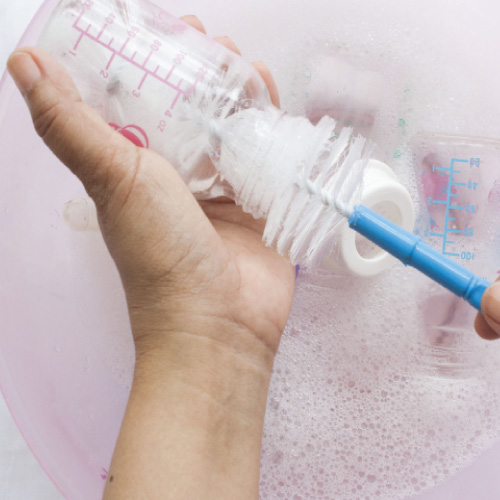Formula Preparation

While breastfeeding is of course the healthiest feeding practice for newborns, on occasion this may not be possible for some mothers. Making up baby formula at first may seem a bit daunting, but your confidence will grow after you follow the guides below a couple of times.
- Wash all the bottles in hot soapy water, squirting water through the teats and using a bottle brush to ensure that everything is clean.
- Sterilise all of equipment including the lids. You can either use one of the many sterilising units available today, or full a large pot of water with warm tap water, submerge everything into this, bring to the boil and boil for five minutes.
- Then fill the jug with cold water and boil. Do not use pre-boiled water because this will not be hot enough to dissolve the powder.
- Poor the required amount of water for your baby's age into the bottle and allow to cool to just above warm, this will allow the powder to dissolve whilst ensuring that the formula can be placed straight into the fridge. If the water becomes too cold then empty a little out and top up with fresh boiled water so the formula powder/nutrients dissolve correctly.
- Carefully add the scoops of formula powder to the water, as per manufacturers scoop amount. After scooping up the formula tap the scoop on the side of the container to make sure there are no air pockets in the powder then level with a clean knife, or on the tin if the manufacturers have provided a metal piece at the top to do this.
- Place the bottle top on and shake to dissolve the powder.
- Refrigerate. Formula has to be used within 24 hours of making it and you can make 24 hours of feeds up in one go.
Often the quantities on the formula tins for each age go well beyond the capacity of a newborns stomach ,which sees nutrients being pushed through the system too quickly. This has organs trying to process nutrients that they actually can't, which contributes to communicated discomfort and inconsolable crying – often leading to a disgnosis of reflux and/or colic. To find out what quantities are suitable for your baby at each age click here and please read more about your baby's natural digestive function within this article called 'The witching hour - it is not normal.'



